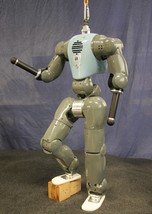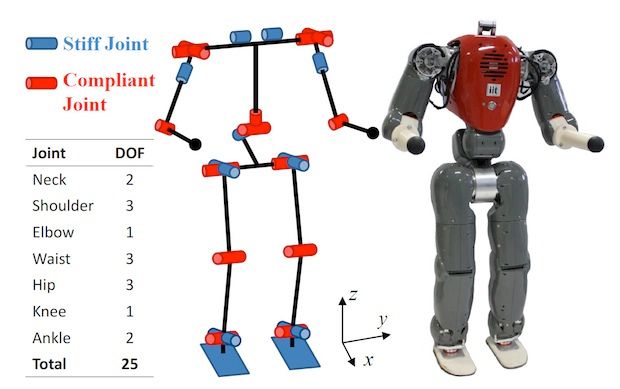/ News

This Humanoid Robot Gets Pushed Around But Stays on Its Feet
Most humanoid robots developed over the past few decades have had stiff joints, and that's a problem if they're ever going to interact with people. Their unyielding arms and legs could injury a person if they accidentally whack someone, or if they lose balance and fall down. Lately there's been a growing interest in developing robotic joints with variable stiffness, which would improve their safety, but so far few groups have built a complete robot. Now a team from the Italian Institute of Technology (IIT) is approaching that goal with their robot COMAN (COmpliant huMANoid).
Modeled on a four-year-old child, COMAN is 94.5 cm tall (from foot to neck) and weighs 31.2 kg. It features 25 degrees of freedom (DOF), and a combination of stiff and compliant joints (see diagram below). The compliant joints (14 DOF) rely on series elastic actuators. These actuators—a custom design created by the IIT team—are applied to the the flexion/extension of the arms and legs, and are both small and modular, which makes them ideal for multi-DOF robots like humanoids. The researchers have also developed custom torque sensors for each of the elastic joints, including a 6-axis force/torque sensor for the ankle joints.

So what exactly does this compliance get you? The elastic actuators literally add a spring to COMAN's step: in walking experiments the robot's hardware naturally absorbed the ground reaction forces of each footstep "without additional control enforcement, which is difficult to be realized by the stiff actuated humanoids if no particular foot mechanism or active control is applied." And when they implemented a stabilization control method, the robot steadied itself on a moving platform and when it was knocked around. Watch:
COMAN's internal structure is made of titanium alloy, stainless steel, and aluminum alloy, covered by an ABS plastic exoskeleton. The images below show the location and structure of the series elastic actuators (SEA) on the robot's hips, knees, ankles, shoulders, and elbows.

In the course of developing their own compliant humanoid, the team also devised a method for determining the optimal joint elasticity, which until now has largely been a time-consuming trial and error process with scant documentation. Their method provides a framework for other researchers exploring compliant robots and is based on resonance analysis and energy storage maximization criteria.

Some of the earlier robots to explore compliant joints include Waseda University's Wendy (1998) and Twendy-One (2007), service robots intended to assist the elderly. For safety reasons they featured compliant arms using specially developed joint mechanisms that were somewhat bulky. More recently, Meka Robotics has produced a humanoid torso with compliant arms, and Samsung's Roboray and the German Aerospace Center's DLR-Biped have torque-controlled legs. Rethink Robotics' Baxter also features compliant arms.
But the IIT team, which includes Nikos G. Tsagarakis, Stephen Morfey, Gustavo Medrano Cerda, Zhibin Li, and Darwin G. Caldwell, is among the first to build a compliant humanoid with both arms and legs. And if you're wondering why the robot is headless, dont' worry: there is a head in the works. And we hear the researchers have also completed a pair of hands. We look forward to seeing those new parts integrated into the robot soon.
Source: http://spectrum.ieee.org/automaton/robotics/humanoids/iit-coman-humanoid-robot
/ About us
Founded by Russian entrepreneur Dmitry Itskov in February 2011 with the participation of leading Russian specialists in the field of neural interfaces, robotics, artificial organs and systems.
The main goals of the 2045 Initiative: the creation and realization of a new strategy for the development of humanity which meets global civilization challenges; the creation of optimale conditions promoting the spiritual enlightenment of humanity; and the realization of a new futuristic reality based on 5 principles: high spirituality, high culture, high ethics, high science and high technologies.
The main science mega-project of the 2045 Initiative aims to create technologies enabling the transfer of a individual’s personality to a more advanced non-biological carrier, and extending life, including to the point of immortality. We devote particular attention to enabling the fullest possible dialogue between the world’s major spiritual traditions, science and society.
A large-scale transformation of humanity, comparable to some of the major spiritual and sci-tech revolutions in history, will require a new strategy. We believe this to be necessary to overcome existing crises, which threaten our planetary habitat and the continued existence of humanity as a species. With the 2045 Initiative, we hope to realize a new strategy for humanity's development, and in so doing, create a more productive, fulfilling, and satisfying future.
The "2045" team is working towards creating an international research center where leading scientists will be engaged in research and development in the fields of anthropomorphic robotics, living systems modeling and brain and consciousness modeling with the goal of transferring one’s individual consciousness to an artificial carrier and achieving cybernetic immortality.
An annual congress "The Global Future 2045" is organized by the Initiative to give platform for discussing mankind's evolutionary strategy based on technologies of cybernetic immortality as well as the possible impact of such technologies on global society, politics and economies of the future.
Future prospects of "2045" Initiative for society
2015-2020
The emergence and widespread use of affordable android "avatars" controlled by a "brain-computer" interface. Coupled with related technologies “avatars’ will give people a number of new features: ability to work in dangerous environments, perform rescue operations, travel in extreme situations etc.
Avatar components will be used in medicine for the rehabilitation of fully or partially disabled patients giving them prosthetic limbs or recover lost senses.
2020-2025
Creation of an autonomous life-support system for the human brain linked to a robot, ‘avatar’, will save people whose body is completely worn out or irreversibly damaged. Any patient with an intact brain will be able to return to a fully functioning bodily life. Such technologies will greatly enlarge the possibility of hybrid bio-electronic devices, thus creating a new IT revolution and will make all kinds of superimpositions of electronic and biological systems possible.
2030-2035
Creation of a computer model of the brain and human consciousness with the subsequent development of means to transfer individual consciousness onto an artificial carrier. This development will profoundly change the world, it will not only give everyone the possibility of cybernetic immortality but will also create a friendly artificial intelligence, expand human capabilities and provide opportunities for ordinary people to restore or modify their own brain multiple times. The final result at this stage can be a real revolution in the understanding of human nature that will completely change the human and technical prospects for humanity.
2045
This is the time when substance-independent minds will receive new bodies with capacities far exceeding those of ordinary humans. A new era for humanity will arrive! Changes will occur in all spheres of human activity – energy generation, transportation, politics, medicine, psychology, sciences, and so on.
Today it is hard to imagine a future when bodies consisting of nanorobots will become affordable and capable of taking any form. It is also hard to imagine body holograms featuring controlled matter. One thing is clear however: humanity, for the first time in its history, will make a fully managed evolutionary transition and eventually become a new species. Moreover, prerequisites for a large-scale expansion into outer space will be created as well.
Key elements of the project in the future
• International social movement
• social network immortal.me
• charitable foundation "Global Future 2045" (Foundation 2045)
• scientific research centre "Immortality"
• business incubator
• University of "Immortality"
• annual award for contribution to the realization of the project of "Immortality”.



 LinkedIn
LinkedIn
 LiveJournal
LiveJournal
 Google
Google
 Twitter
Twitter
 Facebook
Facebook
 Я.ру
Я.ру
 ВКонтакте
ВКонтакте
 Mail.ru
Mail.ru